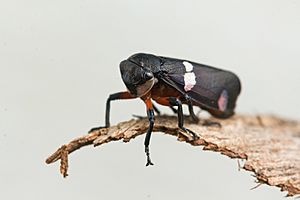Eurymela distincta facts for kids
Quick facts for kids Eurymela distincta |
|
|---|---|
 |
|
| Scientific classification | |
| Kingdom: | |
| Phylum: | |
| Class: | |
| Order: | |
| Family: | |
| Genus: |
Eurymela
|
| Species: |
E. distincta
|
| Binomial name | |
| Eurymela distincta Signoret, 1850
|
|
| Synonyms | |
|
Eurymela vicina Signoret, 1850 |
|
The Eurymela distincta is a type of leafhopper that lives in Australia. It has a unique wedge-shaped body and is known for its bright colors. These insects are often found on eucalyptus trees, which are their main food source. They also have an interesting relationship with ants, who enjoy a sweet treat they produce!
Contents
What Does It Look Like?
The Eurymela distincta is a medium-sized insect. Adult males are about 10–12 mm long, while females are a bit bigger, around 12–14 mm. Its head is black with cream or white parts near its mouth. The top of its body, called the pronotum and scutellum, is black.
Its main wings, called tegmen, are black and can have a blue or purple shine. They often have one to three white stripes across them. The edges of its wings are black. Its legs are bright scarlet (red) close to its body and turn black further down. The underside of its body is also scarlet.
What Does It Eat?
This leafhopper mainly eats the sap from certain types of Eucalyptus trees. Its favorite trees include the bangalay (Eucalyptus botryoides) and the apple box (Eucalyptus bridgesiana). It has also been seen feeding on manna gum (E. viminalis), black gum (E. aggregate), and Camden woollybutt (E. macarthurii).
Friends with Ants?
Eurymela distincta nymphs (young leafhoppers) and adults produce a sugary liquid called "honeydew" as they feed. This honeydew is a favorite food for ants! Up to 20 ants from the Iridomyrmex genus might gather around a single leafhopper to collect this sweet treat. These same ants also look after other insects, like scale insects, that live on the same trees.
Life Cycle and Reproduction
In places like Bungendore, New South Wales, Eurymela distincta usually reproduces once a year during the Australian spring. A single pair of leafhoppers will often use one tree for breeding.
Mating happens between September and October. Females lay their eggs from October to December. They make a small cut, about 1.5–3.8 cm long, in a tree branch. Inside this cut, they lay around 12 slender, 2mm long eggs. They then cover the eggs securely with a white, frothy substance.
Young leafhoppers, called nymphs, start hatching in November. They become adults by February. When a nymph first emerges, it's transparent with red eyes. It quickly changes into a black nymph within about 15 minutes and starts to feed. The nymphs then gather in large groups at the base of new branches to feed.
There are five stages, called instars, that a nymph goes through as it grows. The first stage looks a bit like a black spider with red eyes and a white belly. By the second stage, it starts to get the red abdomen that adults have, and its body becomes longer.
Where Do They Live?
Eurymela distincta has been found in various parts of Australia, including Sydney, Bombala, New South Wales, Nunawading, Victoria, and Hobart, Tasmania.
Adult leafhoppers usually spend the winter in a quiet state, almost like hibernating. However, they might come out on warm, sunny winter days. Very cold winters or strong summer hailstorms can be dangerous for them and might even kill them.
Natural Enemies
The eggs of Eurymela distincta can be attacked by tiny wasps. Two different types of mymarid wasps and one dryinid wasp from the genus Anteon are known to be parasites of their eggs. This means the wasps lay their own eggs inside the leafhopper eggs, which then stops the leafhopper from developing.
Classification
This species was first described in 1850 by a French scientist named Victor Antoine Signoret. He also described another similar species at the same time. Later, other scientists, like Francis Walker and George Willis Kirkaldy, studied these leafhoppers and helped to confirm that some of the different names given to them were actually all the same species, E. distincta.

